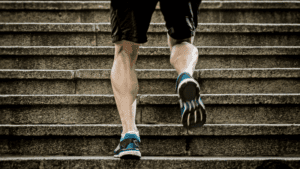Unfortunate and disappointing, injuries sustained on the field come with the territory of playing competitive sports. However, many sports injuries are actually sustained or manifest during off-season training or practice, outside of official competition.
These injuries can be avoided by doing the following in your training: improving functional core stability, incorporating dynamic stretching into your workouts, and trying trigger point release methods.
1. Functional Core Stabilization
You’ve likely heard the benefits of working your core, and let’s face it: we all want that six pack. But the benefits of core work come from helping the body to stabilize the hips and torso while running. This requires functional and dynamic exercises that force your body to stabilize through motion.
If You Do: Front Plank
Try: Elbow plank with Heel Lifts
While in elbow plank, lift one heel off the ground an inch, then put down and repeat on the other side. Do 10 on each side. Be sure to keep the hips level and not let one side dip – that’s what stabilizing the core means!
If You Do: Elbow Side Plank
Try: Side Plank with a Twist
In side plank, put your free hand behind your head and twist your torso down, until your free elbow is pointing towards the ground, then rotate back to your start position. Be sure to not to let your torso dip.
If You Do: Sit Ups
Try: Medicine Ball Slams
Stand upright holding a medicine ball. Bring ball overhead and throw the ball straight down as hard as you can, focusing on contracting your abdominals. This exercise puts crunches to shame!
2. Dynamic Stretching
Static stretching may loosen your muscles, but your muscles don’t exist in a purely lengthened position when they’re being used during training. Dynamic stretching focuses on enhancing elasticity – that is, the body’s ability to lengthen and shorten throughout a motion. It holds a stretch for just a few seconds before continuing through the motion, and then returning to the stretch again for a few seconds repeatedly.
Area To Loosen: Gluteals
Try: Knee Grabs
Standing upright, bring one knee to 90 degrees. Hold on to the knee and bring towards opposite shoulder to produce a light stretch in the buttocks. Hold for a few seconds, release, and do the same on the opposite side as you proceed into the next step. Keep moving through each stretch.
Area To Loosen: Hamstrings
Try: Toe Reachers
Standing upright place one foot in front of you a couple inches. Reach toes up towards the sky and push your butt back as you reach towards your toe. The active foot flexion coupled with pushing the sits bones behind you produces the stretch, not you bending down. Hold for a few seconds, release, then take a small step before doing the same on the opposite leg.
Area To Loosen: Hip Flexors
Try: Lunge and Reach
Step forward into a lunge. With your opposite arm, reach up and over towards the same side as the forward leg in an arc shape. You should feel a stretch in the front of the hip. Hold for a few seconds before stepping directly into a lunge on the opposite leg and repeating.
(Related: Examples of dynamic stretches for runners.)
3. Trigger Point Release
 Trigger points are “knots”, or locations in overworked or injured muscles, where tension is being held. Applying pressure to these points can release the tension and allow the muscle to relax. Often, certain points in the body get overused through excessive running and exercise. Routinely releasing these points can help keep them released, free of tension, and lower the risk for overuse injuries.
Trigger points are “knots”, or locations in overworked or injured muscles, where tension is being held. Applying pressure to these points can release the tension and allow the muscle to relax. Often, certain points in the body get overused through excessive running and exercise. Routinely releasing these points can help keep them released, free of tension, and lower the risk for overuse injuries.
Some common points are:
Piriformis: This little muscle is right in the middle of your butt and is responsible for keeping the leg from rotating inwards while running. A tight piriformis is very common, especially in runners or athletes who incorporate run training often.
Remedy: Sit on a tennis or lacrosse ball, applying pressure directly to the prifirormis. Hold for 30 seconds, switch sides, then repeat.
IT Band: Made of fascia, this band runs along the outside of your leg from hip to knee. Fascia is sort of like Saran wrap inside the body. This can get bunched up and stick together, impeding its ability to glide across the muscles, and causing it to become painful.
Remedy: First, release the gluteal muscles (lacrosse ball method discussed above), as tight hips can increase susceptibility for the IT band to be impeded. Then, get a foam roller and roll out the IT band, going slowly and spending extra time on any “knots”.
(Related: Read about other benefits of foam rolling.)
Sports injuries can be frustrating, but you have the tools and power to reduce your chances of sustaining such an injury. Be sure to follow the advice of a qualified sports coach and these three training tips in order to remain healthy throughout your career.
How useful was this post?
Click on a star to rate it!
Average rating 0 / 5. Vote count: 0
No votes so far! Be the first to rate this post.




